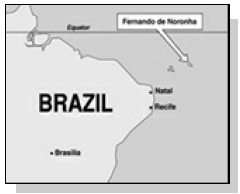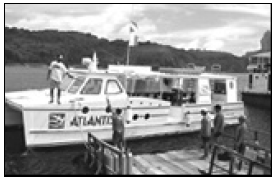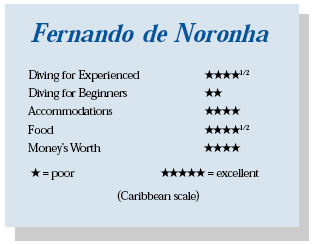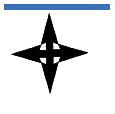Fernando de Noronha, BrazilContents of this Issue: When Your Dry Suit Will Double as Day Wear The Channel Islands, Southern California The Truth About San Salvador’s Algae $5,000 Reward for Errant Spearfisherman When A Travel Agent Sticks To “Its Rules” Editorial Office: Ben Davison Publisher and Editor Undercurrent 3020 Bridgeway, Suite 102 Sausalito, CA 94965 unique diving, better than Caribbean prices from the August, 2001 issue of Undercurrent
Dear Fellow Diver: Remote. Isolated. A protected marine park. Reasonably inexpensive. The possibilities excited me. Then, when I heard “Fernando de Noronha” rolling lyrically off the tongues of those who properly pronounce it -- they roll the r’s and pronounce the “nh” as the “n” in El Niño -- I was hooked. It’s the only inhabited island in an archipelago 120 miles off the Brazilian Coast, four degrees south of the equator. Mention it to a Brazilian and you’ll receive knowing smiles. Mention it to anyone else and expect to answer some questions. As if its remoteness weren’t protection enough, its waters and wildlife are well-guarded by the Brazilian government. Development is severely limited. They closely regulate fishing. It’s even against the law to dive, snorkel or swim with the resident pod of some thousand spinner dolphins, although you can take a boat tour to see them on or just under the surface. The government regulates the number of tourists on the island, partially through a unique tax system. Pay $65 US/person for a week’s stay, $170 for two weeks, and about $800 for a month. The longer you stay, the more you pay per day. Obviously, the government cares more about preserving the ecological integrity than about expanding the economy. So, not many foreign tourists visit the island and the few who do are mostly Europeans. Most visitors are Brazilian, vacationing from the big cities of Sao Paulo or Rio. The place to stay is in one of the hundred small
pousadas, essentially B&B’s. Most are very comfortable,
while a few are first class. After one day at a bad hotel,
which has since closed, we moved to Pousada Ze Maria. Resident chef Roberto prepared three elegant meals daily. Brazilian breakfasts featured meats, cheeses, fresh fruit, and coffee. Lunch and dinner were real events, with several main courses served family style. Entrees of fish, beef, or chicken, prepared with succulent and subtle sauces or simply grilled, were complemented by a variety of vegetable and rice concoctions. They provided fresh juices and soft drinks. Beers, bottled mineral water, and liquors were stocked in the honor bar.
Yet why come to Brazil for the diving? Because it’s a refreshing change from the Caribbean. Jagged, dramatic boulders, all thoroughly encrusted in extremely colorful sponges, algae, and hard coral, dominate the underwater landscape. On a typical dive, I saw large schools of black margates, Bermuda chub, and smallmouth grunts, as well as conies, barracuda, Spanish hogfish, brown chromis, sergeant majors, parrotfish, stingrays, jacks, spotted goatfish, scrawled filefish, French and queen angelfish, blackbar soldierfish, cocoa damselfish, and long-spined squirrelfish. About half the dives I saw nurse and reef sharks. I spotted several green turtles, spiny and slipper lobsters, banded coral shrimp, several crabs, and octopuses. Other divers saw a couple of manta or mobula rays. The waters are alive, and though there may be fewer species than at many Caribbean dive locations, the quantity of fishes, as well as the average size, far surpassed most Caribbean locations. I have rarely seen so many large schools of chub, and I’ve never seen such large schools of grunts. Wide-angle opportunities abound between the beautifully encrusted rock formations and the large schools of fishes, but there were always many small critters and interesting little scenes calling for close-up and macro lenses. Visibility varied from 40 feet to well more than 100 feet, water ran about 82 degrees in May. Noronha’s three dive operators share the same dock. Atlantis Divers, Agua Claris, and Noronha Divers each run two-tank morning and afternoon trips and travel any night with enough guests. If one has the stamina, four to five dives a day are possible. All the operators provide aluminum 80’s and Nitrox on request. Both Agua Claris and Noronha divers can accommodate Trimix fills, using either twin-80’s or big, fat, steel 96’s rigged with dual regulator valves. They required c-cards as well as a signature on standard liability waivers, then you’re off to dive, with no checkout required. (The waivers were in English and the guides spoke enough English so I always knew the drill.) I dived one day with Agua Claris and though their older, wooden boats were without heads or camera rinse tanks and sport flimsy ladders, I had a great day of diving. Although the boat could hold a dozen divers, there were only seven. All Noronha dive operators require buddy diving, so I buddied with Caio Borghoff, an instructor, who proved to be an excellent diveguide and companion. My other dives were with Atlantis Divers, which has two new, well-maintained, roomy catamarans, each with a head, camera rinse, and two solid ladders. Their boats hold about two dozen divers and a half dozen staff. Diving is in small groups, avoiding a cattle-boat feel. The staff is helpful, friendly, and competent, calling roll by name to insure all divers are aboard. When one guest got seasick, they returned to port to drop her off between dives. While sometimes the water was calm and flat, other times there was a moderate current or surge. Whenever the plan called for a trip to turbulent waters, the crew generally offered an alternative at a calm and sheltered site. The guides kept divers of similar skills together, planning the dives carefully so no one had to wait long to be picked up. Buddies could stray from the group, but they strictly prohibited solo diving. They point out any interesting critters they find along the way. Pedras Secas (or Dry Rocks) was a drift dive among colorful boulders strewn along a jagged underwater cliff. Swells of 4-6 feet created a surge as deep as 40 feet. Here, thousands of smallmouth grunts congregated with other species, all milling about amid dramatic piles of sponge-encrusted boulders that formed a labyrinth of pathways, making this a very special dive. At Cabeço da Sapata, the entire dive took place around one pinnacle. At the bottom of the rock -- about 110 feet deep -- several 6-8 foot reef sharks patrolled the depths, warily maintaining their distance. I shot images of colorful rocks and clouds of grunts and chub, looking up the rock face toward the sun above. Slowly I circled the rock as I ascended, passing fish and critters along the way. I finished the dive near the pinnacle’s peak, where the sun highlighted huge clouds of grunts, chub, parrotfish, conies, and angelfish rocking in the surge. At the surface, the water boiled from the force of the crashing waves. The boat pulled up a few fin kicks from the rock, allowing an easy and effortless end to the dive. Another classic Noronha dive is deep and not for everyone. The wreck of the Corveta lies upright in the sand at 200+ feet, with the deck at 185 feet. It can be dived on air or Trimix, depending on one’s training. Guests diving air used special steel tanks fitted with dual valves for redundant first stages. Atlantis Divers supplied a ScubaPro first and second stage for backup so each diver had two independent reg sets. Highly trained technical divers escorted two or three divers at a time. While bottom time is only 15 minutes, I stayed down 45 minutes to complete decompression. On my first dive to the Corveta, I saw a huge Jewfish -- a.k.a. Goliath Grouper -- hanging around the bow-mounted 40-millimeter deck gun. After he posed for several shots with the wreck and my guide in the background, I took a quick tour of the pilothouse. The ship radio’s microphone still dangled on its coiled cord, tempting me to radio the boat for a few more tanks so I could extend our stay. The wreck was covered in red and orange encrusting growths and swarming with brown chromis and blackbar soldierfish. The 15 minutes went all too quickly, although it was not difficult to use up an entire roll of 36 exposures in the brief time. When I was not diving,
I visited several exquisite
sparsely peopled beaches.
Transportation around the
island is by small cars, like
golf carts, which rent for
$30/day. For another $30 you
can get a driver. My wife
spent most of her days either
relaxing and reading at the
pousada, or touring the island
with a driver to take photographs. The scenery is spectacular,
with rugged volcanic
rock formations, tropical
forests, gorgeous beaches and
scenic mountains. Shopping is
limited and the nightlife is
nonexistent, so restaurant
hopping is the entertainment.
While I found it difficult to
leave the wonderful fare and
hospitality of Ze Maria, I
enjoyed the Tartarugao Boldro
with its excellent steak and
seafood dishes, served on
flaming platters. Bring plenty of cash. Few businesses take credit cards (those that do prefer VISA). Travelers checks and cash are unobtainable if you run out. I never leave cash in hotel rooms, going as far as to take it underwater with me in an old, gutted, Ikelite Mini-C flashlight housing -- my underwater wallet. One day, after grabbing a bite to eat at Elda’s Restaurante E Bar Visual, I headed off to catch the afternoon dive. Once underwater, I remembered I had left my trusty old Mini-C on the bar! The next morning, I knocked on Elda’s door -- she lives in rooms adjacent to her restaurant -- and when she saw me she immediately produced my missing flashlight, complete with its precious contents. That’s just how the people are on Fernando. The staff at Ze Maria even mailed my wife a T-shirt she had inadvertently left there, without even being asked. After eight days, I concluded that Fernando de Noronha was even more beautiful than the sound of its name. Unspoiled natural beauty abounds both above and below the surface of the water. It is a very special and timeless place, reminiscent in ways of some less commercialized islands in the Caribbean -- say, for example, the north side of Tobago -- but with its own charms. With its excellent diving, exceptional hospitality, and exquisite food, Noronha has won my heart. -- P.K.
|

I want to get all the stories! Tell me how I can become an Undercurrent Online Member and get online access to all the articles of Undercurrent as well as thousands of first hand reports on dive operations world-wide
| Home | Online Members Area | My Account |
Login
|
Join
|
| Travel Index |
Dive Resort & Liveaboard Reviews
|
Featured Reports
|
Recent
Issues
|
Back Issues
|
|
Dive Gear
Index
|
Health/Safety Index
|
Environment & Misc.
Index
|
Seasonal Planner
|
Blogs
|
Free Articles
|
Book Picks
|
News
|
|
Special Offers
|
RSS
|
FAQ
|
About Us
|
Contact Us
|
Links
|
3020 Bridgeway, Ste 102, Sausalito, Ca 94965
All rights reserved.

 The
owner, Ze Maria, was a kind and generous host, keeping four clean and comfortable rooms in a small wooden
house surrounded by lush tropical vegetation with
beautiful views of the island’s spectacular natural
beauty. From the pousada’s wrap-around porch,
we looked in one direction at a valley with distant
hills and the Atlantic Ocean visible in the
background. In the other direction, beyond rolling
fields, a massive volcanic rock jutted a hundred
feet above a lushly forested hillside, towering
above us like some huge, prehistoric monolith. The
small air-conditioned bedrooms had plenty of closet
and drawer space. The large, comfortable, common
living room, complete with a well-stocked
honor bar, opened into the dining area where we
dined with other guests at a large table with Ze Maria sitting at the head. His permanent
smile lines and kind eyes set the tone for employees and guests alike. Though
he and his staff spoke practically no English -- and we spoke absolutely no
Portuguese -- I can’t remember ever
feeling this level of hospitality
anywhere else. (A new pousada, the
Dolphin, has a swimming pool with a
nearby bar, a sauna, restaurant and
English-speaking personnel.)
The
owner, Ze Maria, was a kind and generous host, keeping four clean and comfortable rooms in a small wooden
house surrounded by lush tropical vegetation with
beautiful views of the island’s spectacular natural
beauty. From the pousada’s wrap-around porch,
we looked in one direction at a valley with distant
hills and the Atlantic Ocean visible in the
background. In the other direction, beyond rolling
fields, a massive volcanic rock jutted a hundred
feet above a lushly forested hillside, towering
above us like some huge, prehistoric monolith. The
small air-conditioned bedrooms had plenty of closet
and drawer space. The large, comfortable, common
living room, complete with a well-stocked
honor bar, opened into the dining area where we
dined with other guests at a large table with Ze Maria sitting at the head. His permanent
smile lines and kind eyes set the tone for employees and guests alike. Though
he and his staff spoke practically no English -- and we spoke absolutely no
Portuguese -- I can’t remember ever
feeling this level of hospitality
anywhere else. (A new pousada, the
Dolphin, has a swimming pool with a
nearby bar, a sauna, restaurant and
English-speaking personnel.)
 I also
enjoyed the Restaurante
Ecologico, known for its lobster
and octopus. At the Restaurante E Bar Visual, a short walk
up the hill from the little shopping
area just above the dock, chef and owner
Elda prepares tasty octopus, fish, and
chicken dishes. Try a side order of her
macaxeira, a dish similar to but much
tastier than French fries.
I also
enjoyed the Restaurante
Ecologico, known for its lobster
and octopus. At the Restaurante E Bar Visual, a short walk
up the hill from the little shopping
area just above the dock, chef and owner
Elda prepares tasty octopus, fish, and
chicken dishes. Try a side order of her
macaxeira, a dish similar to but much
tastier than French fries. Diver’s Compass: Sunie at Grand Tours and Travel, Inc.,(800)591-
2955; (954) 472-7163; e-mail:
Diver’s Compass: Sunie at Grand Tours and Travel, Inc.,(800)591-
2955; (954) 472-7163; e-mail: 